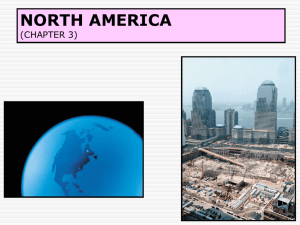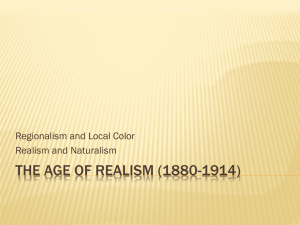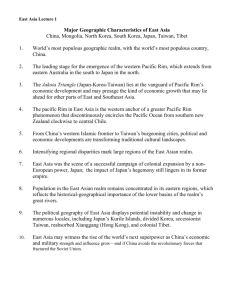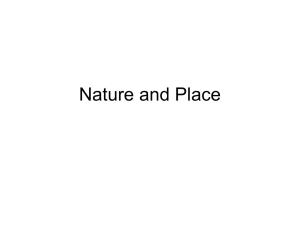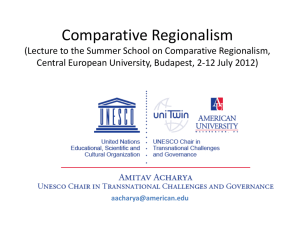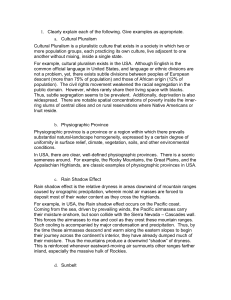North America
advertisement
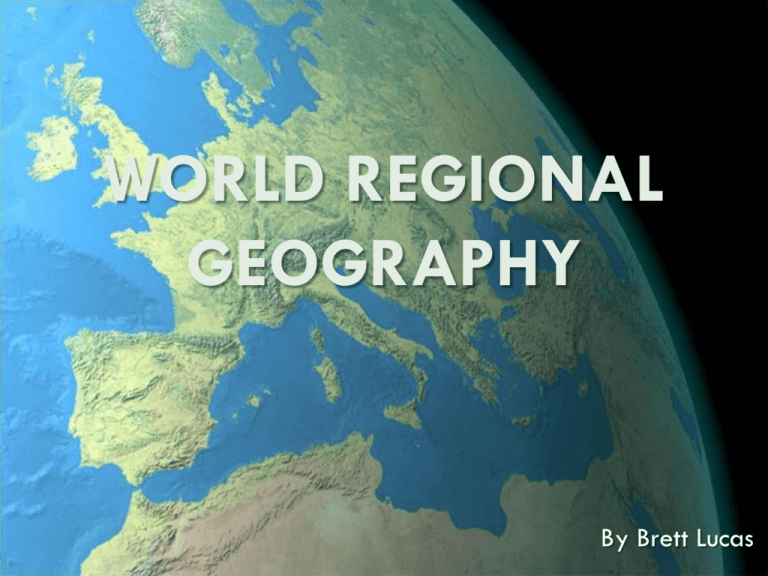
WORLD REGIONAL GEOGRAPHY By Brett Lucas NORTH AMERICA – Part 2 Regions Regions of the Realm Maritime Northeast French Canada Core Continental Interior South Southwest Western Frontier Northern Frontier Pacific Hinge Regionalism in Canada: Divisive Forces: Canada’s Spatial Structure World’s second-largest territory divided into only 13 subnational entities, known as provinces: 4 Atlantic Provinces – 2 core Hudson Provinces 3 central Prairie Provinces – 1 Pacific Ocean Province 3 Arctic North territories Population is clustered in a discontinuous ribbon along the coasts and border with the United States: Settlement conditioned by the environment Cross-border affinities with American cities Regionalism in Canada: Divisive Forces: Cultural Contrasts Divided by culture and tradition: English vs. French Quebec nationalism: Center of Francophone Canada Tests Canada’s federal system At times, demand for outright separation In decline, due to laws enacted to reassure primacy of Québécois culture Regionalism in Canada: Divisive Forces: The Ascendancy of Indigenous Peoples Rising consciousness among indigenous groups: First Nations Métis and Inuit groups Indigenous concerns: Land claim agreement between Inuit people and federal government led to the newest Territory of Nunavut. Federal government must help protect aboriginal rights and claims against the provincial governments. Recognition of land rights allows these groups to share in economic activity and income generated by resources within each province’s territory. Regionalism in Canada: Divisive Forces: Centrifugal Forces Forces of devolution threaten to weaken the state: Tensions between provinces result from federal concessions to Quebec. Western provinces argue that political equality among provinces is a basic principle. Economic integration in NAFTA: Strengthens cross-border linkages between southern Canadian provinces and the United States. Functional reorientations create potential for devolutionary challenges in the future. Regionalism & Ethnicity in the United States As compared with Canada… No serious contemporary campaign for secession, or withdrawal for political independence, since the Civil War. Indigenous peoples were weakened by westward push of European settlers: Loss of population and territory Little political power Regionalism & Ethnicity in the United States Immigration and shaping of U.S. regional geography: African Americans Forced migration as slaves into Southeast plantations Moved from and then back to the Southeast Hispanic Americans Legacy of Southwest as Mexican territory Concentrated in the Southwest, but growing elsewhere – Asian Americans • Growing and diverse minority that is more territorially clustered than other groups • Mostly found along Pacific Rim Regionalism & Ethnicity in the United States Map Analysis Activity: Ethnic Pattern Contexts 1. How does each ethnic group’s pattern illustrate the source and context of its global migration? 2. What else can explain these contemporary patterns? 3. What does the percent classification reveal about the relative size of these groups? The North America Core Core of both countries: Contains largest cities, each country’s capital, economic and media centers, hubs of research and education, and major transportation systems Contains more than 1/3 of each country’s population Influence extends beyond the realm The North America Core Growth of the core: The CBDs of thriving manufacturing cities grew upward, while urban peripheries grew outward. In time, nearby cities coalesced into an expansive metropolitan area known as a megalopolis: In Canada, the urban axis from Windsor to Quebec is known as Main Street. In the United States, the Atlantic seaboard from Boston to Washington, D.C., is called Megalopolis or Bosnywash. Core is center of globalization Rise of the information economy as the American Manufacturing Belt goes into decline Among the Realm’s Great Cities: Chicago Crossroads centrality Lake Michigan connected to Mississippi River via the Chicago River (now a canal) Hub of air and rail transportation network Leading manufacturing and industrial technology center Engendered growth as a commercial center Post-industrial transition Grappling with competition from outer city of “Chicagoland” Reinvention as a service-center and urban playground Concept Caching: Millennium Park, Chicago IL © Sarah Goggin The Maritime Northeast North of the Core Relaxed economic development Maritime orientation and rural character Difficult environments and limited resources Primary industries endure alongside growing recreation and tourism © H.J. de Blij, P.O. Muller, and John Wiley & Sons, Inc. French Canada Francophone Canada: Quebec and Acadians in New Brunswick Prospects: Montreal’s technologically advanced economy Quebec’s uncertainty with nationalist efforts Acadians’ acceptance of multiculturalism Wealth from hydroelectricity Among the Realm’s Great Cities: Montreal Cultural capital of Francophone Canada Ethnolinguistic division: East End French West End English Costs to city’s prosperity Changes today: Increasing linguistic mixing and intermarriage Building foreign-trade ties and advanced technologies The Southeast Uneven geography of development: Sunbelt migration boom hit some cities and agricultural areas, misses others Wide income gap Environmental disasters: Hurricanes Gulf oil spill Internationalization of South Florida: Air conditioning, air travel, and Cubans Miami as a world city connecting Northern and Southern hemispheres Concept Caching: Two Years After Katrina, New Orleans, Louisiana © Alexander B. Murphy The Southwest Regional identity: aridity and ethnic diversity Diverse economies and challenges: Growing technopoles, or high-technology industrial complexes, and transnational trading via NAFTA Concerns over water supplies and limiting dependency on fossil fuel energy Border region: Substantial Mexican populations, legal and illegal Dangers of racial profiling with state laws aiming to deal with illegal immigration (e.g., Arizona) The Pacific Hinge Entire west coast Functional region: Pacific Rim is a discontinuous region along the Pacific experiencing rapid growth and progress. Pacific Hinge represents the interface between the North America realm and Pacific Rim. Concept Caching: Seattle, Washington © Harm de Blij Economic dynamism, high-technology, and industry Among the Realm’s Great Cities: Los Angeles Immense urban landscape: Product of the automobile age and freeway network Sprawling and multinodal North American metropolis Second largest agglomeration in the realm Anchor of CA megalopolis Leader of Pacific Hinge and eastern Pacific Rim The Western Frontier Region’s environment: remote, dry, and sparsely populated Fastest-growing region Concept Caching: New York Casino in Las Vegas, Nevada Pull factors: sunny climates, open spaces, lower cost of living, and growing job opportunities Slowed with 2008 economic crisis Ultimate frontier city: Las Vegas More than gambling and amusement Other attractions: jobs; low-cost; and sunny weather © Alexander B. Murphy The Continental Interior Dominant agriculture: Breadbasket and Meat Belt Shared history of food processing, packing, and marketing Farming and energy: Corn for feed, now in need as ethanol Losing population: Outmigration of youth and affluent • Region has weathered the recession with low unemployment and strong incomes. The Northern Frontier Territorially large with sparse and isolated settlements; it includes almost 90 percent of Canada, plus Alaska. Economic bounty: Vast mineral resources Hydropower Oil reserves Vast tar sands, of oil mixed with sand, in Alberta Economic activity and connections infringe on indigenous lands. The Northern Frontier Environmental future: Reserves of oil and natural gas yet to be tapped Demands for preservation Climate change and decline of Arctic Ocean ice cap Logging moratorium in part of Canada’s boreal forests What do you think? 1. Should this sparsely populated region be developed or preserved? Why?
